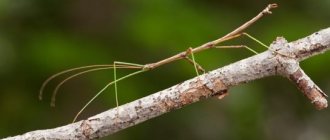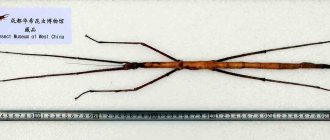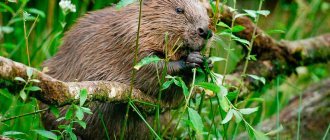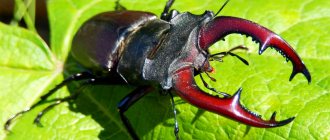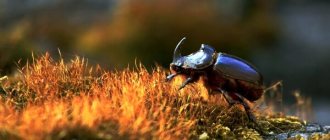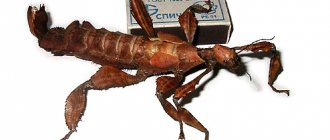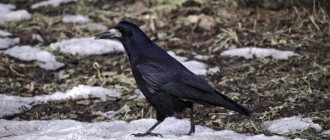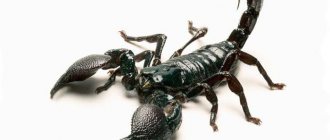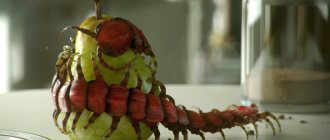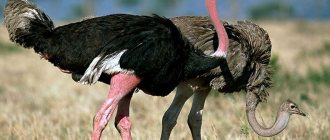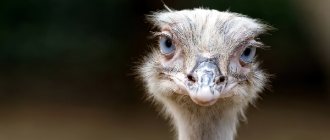Appearance, structure.
The body is narrow, elongated, similar to a rod, a stick (hence the name - stick insect), covered with tiny spines. Color varies: brown, yellowish-gray, brown-green, green. The body length (including a mustache 1.5 cm long) of females is 11 cm, the body length of males is 7.5 cm. Males are not only shorter, but much slimmer and thinner than females. Females, unlike males, have spike-like projections about 2 mm long above their eyes. Neither females nor males have wings. Larvae differ from adults only in size. The eggs are 3 mm long and 1.5 mm in diameter, and have a protruding cap. The color of the eggs is gray with dark speckles.
Annamese stick insect, adult, female:
Annamese stick insect eggs:
Annamese stick insect characteristics:
The appearance of stick insects is quite similar to a green twig, which is where these insects get their name. The color of Annamese stick insects is green, in various variations of this color at different stages of life, before and after molting. The size of the Annamese stick insect can range from 2 to 10 or more centimeters, depending on age. Insect lovers are attracted to them not only by their appearance, but also by their reproduction feature (more on this in the corresponding section). The lifespan of the Annamese stick insect is approximately 1-1.5 years, again, depending on temperature and other conditions
Reproduction.
Annamese stick insects are capable of reproducing by amphimictic (through fertilization of a female by a male) and parthenogenetic (parthenogenesis) methods. The female begins laying eggs about two weeks after her last molt and continues to do so throughout her life. One female is capable of laying more than 1000 eggs. The female throws the mature egg out of the ovipositor with a sharp movement of the abdomen. The eggs are incubated on the forest floor for about two months. The length of the larva emerging from the egg is 1.5 cm. Development from egg to adult takes 3-4 months, during which time the stick insect molts 6 times.
Annamese stick insect - eggs and “newborn” larva:
Ghost squad
Today, 455 genera and approximately three thousand species of stick insects are known. All insects of this order have an extraordinary appearance, allowing them to be invisible to predators. With the help of a special color, body shape and various outgrowths, they copy the leaves and branches of trees. Thanks to this ability, they are called stick insects, leaf insects, ghost insects, and even horror stories.
These insects look very different. For example, Phyllium giganteum has the appearance of a wide, bright green leaf, while Dryococelus australis is black or brown, has a wide body and is a bit like a mole cricket. The Annamese stick insect is one of the most famous representatives of the order and lives up to its name more than others. It has a very long body and really resembles a branched twig. Having met it in nature, you may not even realize that this is a living creature in front of you.
Keeping in captivity.
Conditions of detention
An aquarium of 40 liters or more with a mesh lid is suitable for keeping Annamese stick insects. The mesh should occupy 2/5 of the lid area. You can use a plastic mosquito net - even larvae that have just emerged from the eggs will not pass through it. A maximum of 8 adult stick insects can be placed in such an insectarium, at a rate of 5 liters. volume per insect.
Mosquito net:
At the bottom of the aquarium you need to lay a layer of soil a few centimeters deep (or peat) and compact it tightly. The soil in the insectarium should always remain moist to maintain a constant high level of humidity. Once a day, the insectarium should be sprayed with settled water at room temperature from a spray bottle.
Insectarium for stick insects 1 - aquarium, 2 - lid, 3 - mosquito net, 4 - soil, 5 - container with food plants
Feeding
Raspberry leaves are excellent as the main food for Anama stick insects. You can also feed the stick insects leaves of rowan, oak, rose hips, and red currants. In the absence of tree leaves, in early spring, you can give stick insects (Aegopodium podagraria) and dandelion leaves (Taraxacum officinale). In winter, you can give strawberry and river grass leaves (remain green under the snow), lettuce leaves, as well as leaves of some indoor plants, such as Tradescantia fluminensis, Chinese rose (Hibiscus rosa-sinensis), Ficus benjamina. Forage plants are placed in water in a vessel with a lid in which holes are made. A lid is necessary to prevent insects and eggs from getting into the water.
Jar for fodder branches:
The leaves of the river grassweed (Geum rivale) remain green under the snow; they can be fed to stick insects in winter and early spring:
Breeding
As noted above, Annamese stick insects are capable of parthenogenesis, that is, to breed this species in an insectarium, just one female is enough, which is capable of laying hundreds of eggs. However, it should be borne in mind that not all of these eggs are viable. If the insectarium is large and there are not many stick insects in it, then the eggs can be left to incubate right in it, on the ground where they fell. If the insectarium is small and the density of insects is high, then it is better to incubate the eggs separately, in the same insectarium, but intended for young animals. When collecting eggs, you need to remember that they are very fragile and can easily be crushed with your fingers, so it is better to collect the eggs by sweeping them onto a scoop with a brush. The incubation period of Annam stick insect eggs at a temperature of 25°C is about 2 months, at a temperature of 20°C – more than 3 months.
Annamese stick insect - larva, eggs:
Annamese stick insect feeding:
Annamese stick insects are quite demanding when it comes to feeding. As food, they need to be given fresh twigs of plants such as raspberries, blackberries, rose hips, oak, and strawberries. Most often, stick insects are fed with blackberries; the branches must be placed in a container in a special vessel with water, since stick insects may not eat branches lying on the floor. For the winter, feed must be prepared in advance.
You can collect the leaves, put them in a bowl, put them in the freezer, or pick the branches and, putting them in water, put them in a cold place where the branches will lie all winter (thus, you need to do the same with blackberries). In the first case, the leaves must be scalded with boiling water. Acorns are also collected for the winter and sprouted at home. In addition, some owners feed their pets with indoor plants - hibiscus or tradescantia. In this case, preparing food for the winter does not present any particular difficulties.
Population and species status
Photo: What a stick insect looks like
Four species are listed as endangered in the Red Book, two species are on the verge of extinction, one species is listed as endangered, and another is listed as extinct. These types include:
- Carausius scotti - critically endangered, endemic to the small island of Silhouette, which is part of the Seychelles archipelago;
- Dryococelus australis is on the verge of extinction. It was practically destroyed on Lord Howe Island (Pacific Ocean), brought there by rats. Later, thanks to newly found specimens, a program to breed them in captivity was launched;
- Graeffea seychellensis is an almost extinct species that is endemic to the Seychelles;
- Pseudobacteria ridleyi is a completely extinct species. Now known from a single specimen discovered 100 years ago in the tropics on the Malay Peninsula in Singapore.
Serious damage to forestry can occur, especially in monocultures. From Australia to South America, the introduced species Echetlus evoneobertii in Brazilian eucalyptus plantations has come under serious threat. In Australia itself, Didymuria violescens typically causes severe damage to upland forests in New South Wales and Victoria every two years. Thus, in 1963, hundreds of square kilometers of eucalyptus forest were completely neutralized.
What to feed a stick insect?
Stick insects are exclusively and completely herbivorous insects. The ideal food for most species would be currant, raspberry, blackberry, and oak leaves. Linden, rose hips, hawthorn, and cotoneaster are also suitable. Some species also eat privet and rhododendron leaves. The main thing is that the plants are not treated with insecticides and herbicides. When collecting leaves for stick insects, you should definitely make sure that these substances, which are deadly to insects, were not used. The ideal option is to collect food for pets at your own summer cottage or at the plot of your friends, where these substances are not used.
Setting up an insectarium for stick insects
To make insects feel comfortable and as close to their natural environment as possible, you can decorate the insectarium with dry driftwood, multi-colored pebbles, build wigwams from dry branches - in a word, give free rein to your imagination.
The most important thing is to prevent the presence of objects in the insectarium that may contain chemicals so that the insect does not get poisoned.
Greenery should be a mandatory decoration for stick insects' houses. Lilacs, ferns, hibiscus, strawberries, and many other plants that are not poisonous are suitable for this purpose.
How to handle a stick insect?
You can pick up a stick insect, but you need to do this very carefully - after all, this insect is fragile. The largest ones can be lifted by gently grasping the sides of the chest with your thumb and forefinger, but do not press.
When removing a stick insect from a leaf or branch, be careful not to damage its legs. Some stick insects (for example, the jungle nymph) have very strong legs, and there are sharp protrusions on the body, and if you squeeze it carelessly, you can cut yourself until it bleeds. Some species have glands that produce an odorous liquid. If this liquid gets into your eyes, it may cause painful irritation.
But in general, stick insects are cute creatures. They quickly get used to sitting on your hand and behave completely calmly.
With proper care, stick insects will live with you for the entire period allotted to them, which, unfortunately, is not that long - a maximum of one and a half years. And if you're lucky, they may even lay eggs, ensuring a change of generations.
- Stick insect:...
- Stick insects: habitat...
- Why do people...
- Where and when is best...
- How and what to feed...
- African…
Features and habitat
These unique insects prefer to live in the tropics and subtropics. They like dense bushes, shallow lawns with tall grasses, and forests. An important condition for them is a good and sufficiently humid environment.
They are found in India, the South of America, Australia, and European countries. The length of the stick insect depends on the habitat and the species. It can vary from 2 to 35 cm. There are also giant stick insects, whose length is even greater.
The color of insects is dominated by brown and green tones. Each type has a different shape. The body shape of stick insects , which live on tree branches of a thin and long structure.
They have a head, inconspicuous and not conspicuous, an elongated body and long limbs. Both in real life and in photos such a stick insect is difficult to distinguish from a branch. Insects living among the foliage have the same wide and green body.
All types of stick insects have a structure similar to all insects with a head, chest, abdomen, antennae and legs. About the insect’s mouthparts, it can be noted that it is of the gnawing type. Its skin consists of a hard chitinous layer. This layer covers the hypodermal cells with the pigment they contain.
Thanks to these pigments, the insect's body acquires one or another color necessary for it. A variety of factors can influence the change in color. For example, a sudden change in temperature or lighting can serve as an impetus for this.
True, this process lasts in a slow rhythm. Some stick insects are also equipped with wings and elytra. But in flight, almost all of them are not particularly strong. There are species of these insects that have spines on their bodies.
Another amazing and unusual feature of stick insects is the fact that for every male in nature there are approximately 4,000 females, which are much larger in size.
Why are there such serious deviations from the norm we are all familiar with? The fact is that female stick insects are able to lay eggs without males, which is scientifically called parthenogenesis. Another interesting fact is that from eggs resembling a flask, laid by one female, only those similar to her are produced.
The stick insect still has many secrets unknown to people. This insect is still on the verge of being studied. In another way, the insect is called a ghost, specter, or phantom.
There are types of them that are difficult for us to understand to this day. Tubifex stick insects, for example, try to stay in colonies. They hold on to each other with the help of their limbs and build something like suspension bridges from their bodies. Other species of these insects prefer to live in formed tubers.
There are those who, in order to scare the enemy, release unpleasant aromas, or even begin to regurgitate food, thereby trying to disgust the enemy.
are currently very popular among lovers of strange pets . In appearance, they are very reminiscent of a green twig. They are kept in special containers.
For their good development and further reproduction, proper and nutritious nutrition is important. In general, domestic stick insects are not only one of the most outlandish creations of nature. They are one of the least picky pets.
These insects are most common on the Indochina Peninsula, in humid tropical areas. Adult female Anamese reach a body length of 12 cm, and together with the legs - more than 15 cm. Males are smaller - body length up to 9 cm. The abdomen is divided into 8 segments, which gives the insect greater elasticity; the antennae are also segmented. The Anamanian stick insect (Baculum extradentatum) is one of the first ghost insects imported into Europe and bred in captivity (they have also been kept in insectariums for more than 20 years). Now two lines are known: represented by two sexes and parthenogenetic (only females). In nature, males are found much less frequently than females, and they differ in that females have special thyroid-like outgrowths on their heads. Also, females are slightly more plump than males. Life expectancy is approximately 8 months. from the moment of hatching from the eggs.
Nutrition
Stick insects eat a strict diet of dried or fresh leaves of Tradescantia, Canadian oak, blackberries and raspberries. Based on my own experience, I can advise: Canadian oak leaves can be replaced with leaves from ordinary bath brooms (but never from a store, it is advisable to buy them right next to the bathhouse; there are sharp and round leaves - take only the sharp ones). You can add leaves of Chinese (Chinese) cabbage to your food - this is a last resort if the supply is running low and there is nothing to replenish. Remember the main rule: under no circumstances switch abruptly from one leaf to another - the beetles can die from this. Rotten leaves and moldy leaves are also poison for stick insects.
Regeneration and molting of stick insects
If a stick insect accidentally loses its leg, don’t worry, it will recover it within a short time. For a normal life, a stick insect needs at least three legs out of six.
The molting of a stick insect proceeds as follows: the insect will lazily crawl around its “apartment” for some time until it finds a secluded place. Then it will firmly cling to some surface with all its paws, bend its abdomen inward and “crawl” out of its skin. After the stick insect crawls out of its skin for a short time, it will become bright green in color, will actively grow and regenerate its limbs. As soon as the stick insect grows up, it will become its usual “knot” color. I timed it and my molting lasted about a day.
Attention!
Never touch a stick insect while it is molting or help it if it is stuck. You can break the legs, which are very fragile at this time, and kill your pet.
Content
Stick insects can live either in a specially adapted insectarium or in an ordinary plastic water bottle, but not less than a 5-liter bottle. How to adapt a bottle. Using a hot nail, poke many holes in it for ventilation. Cut the top edge of the bottle to form a cap. So the homemade insectarium is ready.
How to set up a feeder for stick insects: find some branch on the street where the thickest branch is as thick as an ordinary pencil, only without thorns. Place this branch in the insectarium bottle so that it is suspended. I drilled a hole in the bottle and attached it to the outside with tape. Why not from the inside? Because while crawling, stick insects will definitely stick to the tape and will not be able to tear off their paws. To this branch, fasten the leaves with threads and attach them. Change them when they are nibbled down to the stem. With a drinking bowl, everything is simple - take an ordinary sprayer (sprayer) and spray the same wall of the bottle every day so that a few droplets form. But don't spray on the beetles - they won't like it. They reproduce well in captivity. Stick insects mate at any time in secluded corners of the insectarium. Then, over the course of 3 months, the female lays approximately six eggs, from which the larvae hatch. Newly born bugs can reach a length of 2.5 cm.
Similar articles:
- Stick insect. Leafweed
- Is a stick insect an insect or a ghost?
- Stick insect. Maintenance, feeding, reproduction
Where does the stick insect live?
Photo: Stick insect
Stick insects can be found in ecosystems all over the world, with the exception of Antarctica and Patagonia. They are most numerous in the tropics and subtropics. The greatest biodiversity of species is found in Southeast Asia and South America, followed by Australia, Central America and the southern United States. More than 300 species inhabit the island of Borneo, making it the richest place in the world for bogeymen (Phasmatodea).
There are approximately 1,500 known species in the eastern region, while 1,000 species are found in neotropical regions and over 440 species in Australia. In the rest of its range, species are decreasing in number in Madagascar and throughout Africa, and from the Middle East to the Palearctic. There are only a few native species in the Mediterranean and Far East.
Interesting fact: One of the species of stick insects living in Southeast Asia, the largest insect in the world. Females of the genus Phobaeticus are the longest insects in the world, reaching a total length of 56.7 cm in the case of Phobaeticus chani, including extended legs.
Habitats with lush vegetation have the highest species densities. Chief among these are forests, and especially the various types of tropical forests. In drier areas the number of species decreases, as well as in higher altitude and therefore colder regions. Members of the genus Monticomorpha have the largest range and are still found at an altitude of 5,000 meters near the snow line on the Ecuadorian Cotopaxi volcano.
Now you know where the stick insect lives. Let's see what he eats.
Habitats
Annamese stick insects live in hot and humid regions of Asia. They inhabit forests, thickets near roads, clearings and woodlands. High humidity and high ambient temperatures are important for them, so they are not found outside the tropics. However, they are not very widespread in the world and live within Indochina and nearby territories. The homeland of stick insects is Laos, Cambodia, Vietnam and Thailand.
How long do stick insects grow?
Giants, like the New Guinea and Indonesian, grow up to 40-45 cm, but they can also be quite tiny. — How long do stick insects live? - They live for about a year. In nature, they live in the tropics, where the change of seasons is insignificant, but even there a period of drought occurs when the vegetation dies.
Interesting materials:
What region is Tula located in? Which cheese has the least calories? In which equation do we need to find the unknown minuend? In what century was the hourglass invented? In what century do the events in the novel Romeo and Juliet take place? In what century did ancient Russian literature appear? At what age is Alla Pugacheva? At what age do guppies acquire color? At what age and from what did Catherine II die? At what age is a goat ready to cover?
